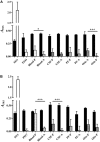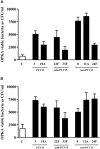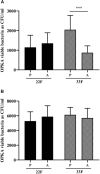Clinical Relevance and Molecular Pathogenesis of the Emerging Serotypes 22F and 33F of Streptococcus pneumoniae in Spain
- PMID: 32174903
- PMCID: PMC7056674
- DOI: 10.3389/fmicb.2020.00309
Clinical Relevance and Molecular Pathogenesis of the Emerging Serotypes 22F and 33F of Streptococcus pneumoniae in Spain
Abstract
Streptococcus pneumoniae is the main bacterial cause of respiratory infections in children and the elderly worldwide. Serotype replacement is a frequent phenomenon after the introduction of conjugated vaccines, with emerging serotypes 22F and 33F as frequent non-PCV13 serotypes in children and adults in North America and other countries. Characterization of mechanisms involved in evasion of the host immune response by these serotypes is of great importance in public health because they are included in the future conjugated vaccines PCV15 and PCV20. One of the main strategies of S. pneumoniae to persistently colonize and causes infection is biofilm formation. In this study, we have evaluated the influence of capsule polysaccharide in biofilm formation and immune evasion by using clinical isolates from different sources and isogenic strains with capsules from prevalent serotypes. Since the introduction of PCV13 in Spain in the year 2010, isolates of serotypes 22F and 33F are rising among risk populations. The predominant circulating genotypes are ST43322F and ST71733F , being CC433 in 22F and CC717 in 33F the main clonal complexes in Spain. The use of clinical isolates of different origin, demonstrated that pediatric isolates of serotypes 22F and 33F formed better biofilms than adult isolates and this was statistically significant. This phenotype was greater in clinical isolates from blood origin compared to those from cerebrospinal fluid, pleural fluid and otitis. Opsonophagocytosis assays showed that serotype 22F and 33F were recognized by the PSGL-1 receptor on leukocytes, although serotype 22F, was more resistant than serotype 33F to phagocytosis killing and more lethal in a mouse sepsis model. Overall, the emergence of additional PCV15 serotypes, especially 22F, could be associated to an enhanced ability to divert the host immune response that markedly increased in a biofilm state. Our findings demonstrate that pediatric isolates of 22F and 33F, that form better biofilm than isolates from adults, could have an advantage to colonize the nasopharynx of children and therefore, be important in carriage and subsequent dissemination to the elderly. The increased ability of serotype 22F to avoid the host immune response, might explain the emergence of this serotype in the last years.
Keywords: PCV-pneumococcal conjugate vaccine; PSGL-1; Streptococcus pneumoniae; biofilms; serotype 22F; serotype 33F.
Copyright © 2020 Sempere, de Miguel, González-Camacho, Yuste and Domenech.
Figures








Similar articles
-
Invasive pneumococcal disease due to 22F and 33F in England: A tail of two serotypes.Vaccine. 2021 Apr 1;39(14):1997-2004. doi: 10.1016/j.vaccine.2021.02.026. Epub 2021 Mar 11. Vaccine. 2021. PMID: 33715901
-
Whole genome characterization of Streptococcus pneumoniae from respiratory and blood cultures collected from Canadian hospitals before and after PCV-13 implementation in Canada: Focus on serotypes 22F and 33F from CANWARD 2007-2018.Vaccine. 2021 Sep 15;39(39):5474-5483. doi: 10.1016/j.vaccine.2021.08.061. Epub 2021 Aug 25. Vaccine. 2021. PMID: 34454785
-
Invasive Streptococcus pneumoniae in Canada, 2011-2014: Characterization of new candidate 15-valent pneumococcal conjugate vaccine serotypes 22F and 33F.Vaccine. 2016 May 17;34(23):2527-30. doi: 10.1016/j.vaccine.2016.03.058. Epub 2016 Apr 13. Vaccine. 2016. PMID: 27085174
-
Systematic Literature Review of the Epidemiological Characteristics of Pneumococcal Disease Caused by the Additional Serotypes Covered by the 20-Valent Pneumococcal Conjugate Vaccine.Microorganisms. 2023 Jul 15;11(7):1816. doi: 10.3390/microorganisms11071816. Microorganisms. 2023. PMID: 37512988 Free PMC article. Review.
-
Pneumococcal Serotype Evolution and Burden in European Adults in the Last Decade: A Systematic Review.Microorganisms. 2023 May 24;11(6):1376. doi: 10.3390/microorganisms11061376. Microorganisms. 2023. PMID: 37374878 Free PMC article. Review.
Cited by
-
Comparative Proteomic Analyses Between Biofilm-Forming and Non-biofilm-Forming Strains of Corynebacterium pseudotuberculosis Isolated From Goats.Front Vet Sci. 2021 Feb 16;8:614011. doi: 10.3389/fvets.2021.614011. eCollection 2021. Front Vet Sci. 2021. PMID: 33665217 Free PMC article.
-
Epidemiology of non-vaccine serotypes of Streptococcus pneumoniae before and after universal administration of pneumococcal conjugate vaccines.Hum Vaccin Immunother. 2021 Dec 2;17(12):5628-5637. doi: 10.1080/21645515.2021.1985353. Epub 2021 Nov 2. Hum Vaccin Immunother. 2021. PMID: 34726580 Free PMC article. Review.
-
Enzybiotic-mediated antimicrobial functionalization of polyhydroxyalkanoates.Front Bioeng Biotechnol. 2023 Jun 28;11:1220336. doi: 10.3389/fbioe.2023.1220336. eCollection 2023. Front Bioeng Biotechnol. 2023. PMID: 37449090 Free PMC article.
-
Molecular characterization, antibiotic resistance pattern and capsular types of invasive Streptococcus pneumoniae isolated from clinical samples in Tehran, Iran.BMC Microbiol. 2020 Jun 16;20(1):167. doi: 10.1186/s12866-020-01855-y. BMC Microbiol. 2020. PMID: 32546124 Free PMC article.
-
Anti-capsular immunity to Streptococcus pneumoniae serotype 22F prevents bacterial transmission in murine colonization and influenza virus co-infection models.Vaccine. 2021 Jan 15;39(3):469-472. doi: 10.1016/j.vaccine.2020.11.075. Epub 2020 Dec 19. Vaccine. 2021. PMID: 33349459 Free PMC article.
References
-
- Aguinagalde L., Corsini B., Domenech A., Domenech M., Camara J., Ardanuy C., et al. (2015). Emergence of amoxicillin-resistant variants of Spain9V-ST156 pneumococci expressing serotype 11A correlates with their ability to evade the host immune response. PLoS One 10:e0137565. 10.1371/journal.pone.0137565 - DOI - PMC - PubMed
LinkOut - more resources
Full Text Sources

